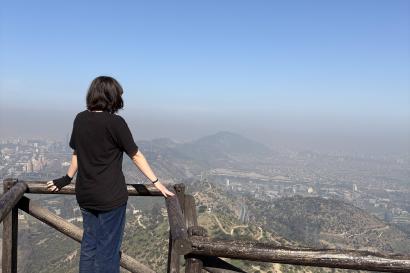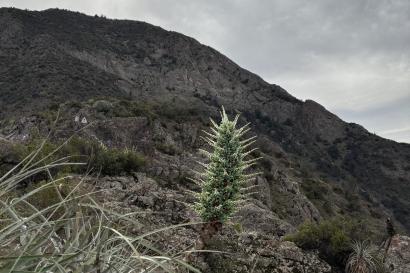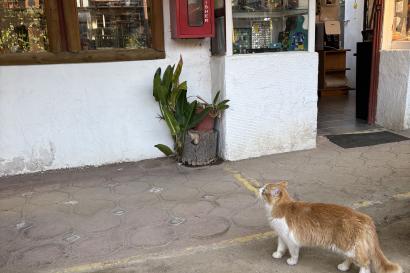Before leaving Chile, I took a final trip to yet another of its dramatic ecosystems – the Atacama Desert. At a base level of 7,900 feet and less than one millimeter of rain per year, it is known as one of the highest, driest places on earth, and certainly did not disappoint in either respect!
We got in late to San Pedro de Atacama, strolling under the expansive sky from the bus station to our lodge. After breakfast in our lodge’s sunny kitchen, we headed out the next day to explore and plan our trip. The town of San Pedro is dusty and lively, its streets lined with travel agencies and shops bursting with colorful textiles. Travel agents stood chatting outside their stores, inviting us in. We stopped in a couple, writing options down on slips of paper. As the slips accumulated, we were offered better and better deals. We settled on two, one to the geysers in El Tatio and the other to the altiplanic lagoons, leaving two days open for more active exploration… our hearts were set on biking and sandboarding our way through the desert.
After lunch, we met at a sandboard rental place and hopped in a van to Valle de Marte, also known as Valle de la Muerte (Mars or Death Valley). By coincidence, the other group in our van was from another IES Abroad program! Hiking up sand dunes at altitude holding the boards behind us, we discovered, was substantially difficult. However, we were rewarded with a magnificent sea of red rocks streaked with white, and a backdrop of far-off volcanoes sloping into the desert. Boarding down, we learned to brake using the “Michael Jackson” (getting up on your toes, if going down frontside). We slid and weaved our way down the dunes, often tumbling into the soft sand. Each time we climbed back up the sun had sunk further into the sandy slopes on the horizon, finally turning the rocks layers of red and pink. We returned to San Pedro to shower off the sand and cook dinner.
The next morning, our alarms sounded at 4:15 and we piled on as many layers as humanly possible in preparation for the geysers. A sleepy van ride took us up over 14,000 ft to El Tatio. As we approached in the near-darkness, we began to see plumes of steam rising into the air all around the crater field before us. The sun quickly rose, and they became fully visible – huge, bubbling pools separated by rock paths that would occasionally erupt in a fountain of water and steam. We huddled next to them in the 14-degree (Fahrenheit!) weather. As it began to warm up, the bravest swam in the warm waters. Battling dizziness and nausea from the altitude, I sat soaking up the sun among the spiky yellow plants and shrubs before we had to get back in the van.
After a lengthy nap and several water bottles to recuperate, we went back to town for dinner at Barros, a charming local establishment with live music. We next made our way down an uneven dirt road past town to the banks of the river. Drawn to a campfire halfway down the dunes, we joined other travelers from Germany, England, and Chile. Endless stars shone above us, blending into the vastness of the Milky Way.
The next day, we were outfitted with mountain bikes, helmets, and neon orange vests for our ride through Valle de la Luna. The 10-mile ride from town was perfectly flat, and we quickly zoomed past the cracked, windswept earth to the park entrance. Once in the park, the road took us past giant dunes that looked like ocean waves, through vast expanses of nothing but sand, and up steep hills past red and white rock formations that rose up, blocking the sky on either side of us. We biked back to town just as the sun was setting, sore all over and barely able to sit down for dinner. We all agreed, though, that it was one of our most magical experiences in Chile, or maybe ever.
Waking up at 6 to squeeze in one more adventure before our flight home that evening, we got on another van with the altiplanic lagoons as our destination. We stopped on our way to see the Tropic of Capricorn. On June 21, just a couple weeks later, the sun would be directly overhead of that exact spot on Inca land, marking the indigenous New Year. Next stop was Socaire, a small village with terraces carved into the land and a stone church with a roof of dried cactus – a vestige of colonization. We warmed ourselves with eggs and avocado on fresh baguette as we looked out at the never-ending salt flats below.
We drove past fields of small plants dotted with purple flowers, ostrich-like rheas, and alpaca-like vicuñas, until we got to the Miñiques and Miscanti lagoons. A fox greeted us as we disembarked, scurrying off behind a rock where it peered at us curiously. The vast lagoons formed a perfect mirror image of the volcanoes above them, the image only occasionally distorted when a vicuña reached its head down to the water for a drink.
Our last stop was at Laguna Chaxa, a shallow but expansive pool of pinks and whites above a crumbly base of salt. Flamingos strutted before us, churning up the water with their feet and then circling around to catch all the tiny shrimp they could find. They eat for 19 hours a day, our guide said, showing us the millimeter-long shrimp that made up the flamingos’ entire diet. The sun rose high into the sky, and we began to shed layers. A UV index of 11 meant we had to go back to the bus before too long.
We ended the trip at Franchuteria, a charming bakery and café tucked in the trees back in San Pedro. With several baguettes for the road, it was back to Calama, and then Santiago.

Thea Lance
<p class="MsoBodyText" style="margin-top:.4pt; margin-right:20.75pt; margin-bottom:.0001pt; margin-left:5.5pt"><span style="line-height:103%">I'm a lover of adventure, whether that's climbing mountains or exploring a new city. This has taken me from my hometown in North Carolina to the arctic circle and beyond, and most recently to Chile! I'm majoring in Biology on a pre-medical track, and I am thrilled to be learning medical Spanish in Santiago this semester.</span></p>








